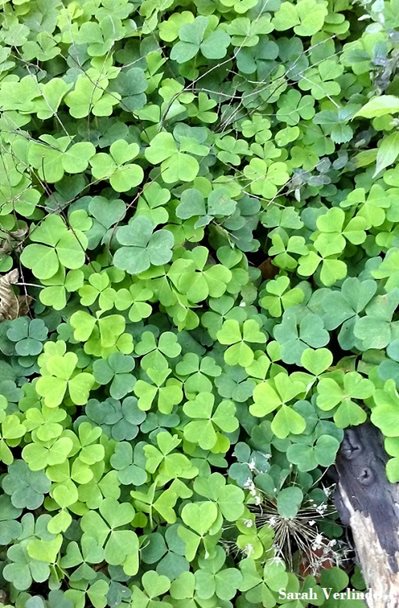Redwood Sorrel
Oxalis oregana – Redwood sorrel
At a Glance:

- Family: Oxalidaceae
- Plant Type: low-growing herbaceous ground cover
- Distribution: Pacific Coast, California to British Columbia
- Habitat: Moist woods, shade
- Height: 8 inches
- Flower/Fruits: delicate white/pink 5-petaled flowers
- Flowering Season: April – September
- Leaves: clover-shaped, 3-part lobed leaf with a cordate/heart shape.
- Generation: Perennial
- Notable feature: This plant is very sensitive to sunlight (blue light) and rain. Once exposed to sunflecks or movement, the leaves will fold back to prevent damage. After the initial disturbance, the leaves will take ten seconds to respond, and six minutes to completely close down. After the disturbance is over, it takes about ten minutes to return to normal.
Commerce and Landscaping
Even though Oxalis is not related to the pea family (Fabaceae) which has clovers in it, Oxalis is grown commercially and sold as clover plants to celebrate St. Patrick’s Day. The clover leaf is considered by many to be a symbol of good luck. Planted in shady areas, redwood sorrel can spread vigorously making an attractive ground cover.
Ethnobotany and Plant Uses
The genus name Oxalis refers to the compound oxalic acid, a tangy, mildly toxic compound in the leaves. The leaves could be eaten in small amounts raw or cooked. Northwest tribes ate the redwood sorrel with dried fish. The plant was also made into a body wash to treat areas of inflammation like arthritis or sore muscles.
References and Resources
- SAPS: https://www.saps.org.uk/saps-associates/browse-q-and-a/426-nyctinasty-and-mimosa-leaf-movement
- US Forest Service: https://www.fs.fed.us/wildflowers/plant-of-the-week/oxalis_oregana.shtml
- WTU Image Herbarium: http://biology.burke.washington.edu/herbarium/imagecollection/taxon.php?Taxon=Oxalis%20oregana
This article was written by Sarah Verlinde. For questions regarding the UWB/CC Plant Tour, contact Sarah at severlin@uw.edu.
